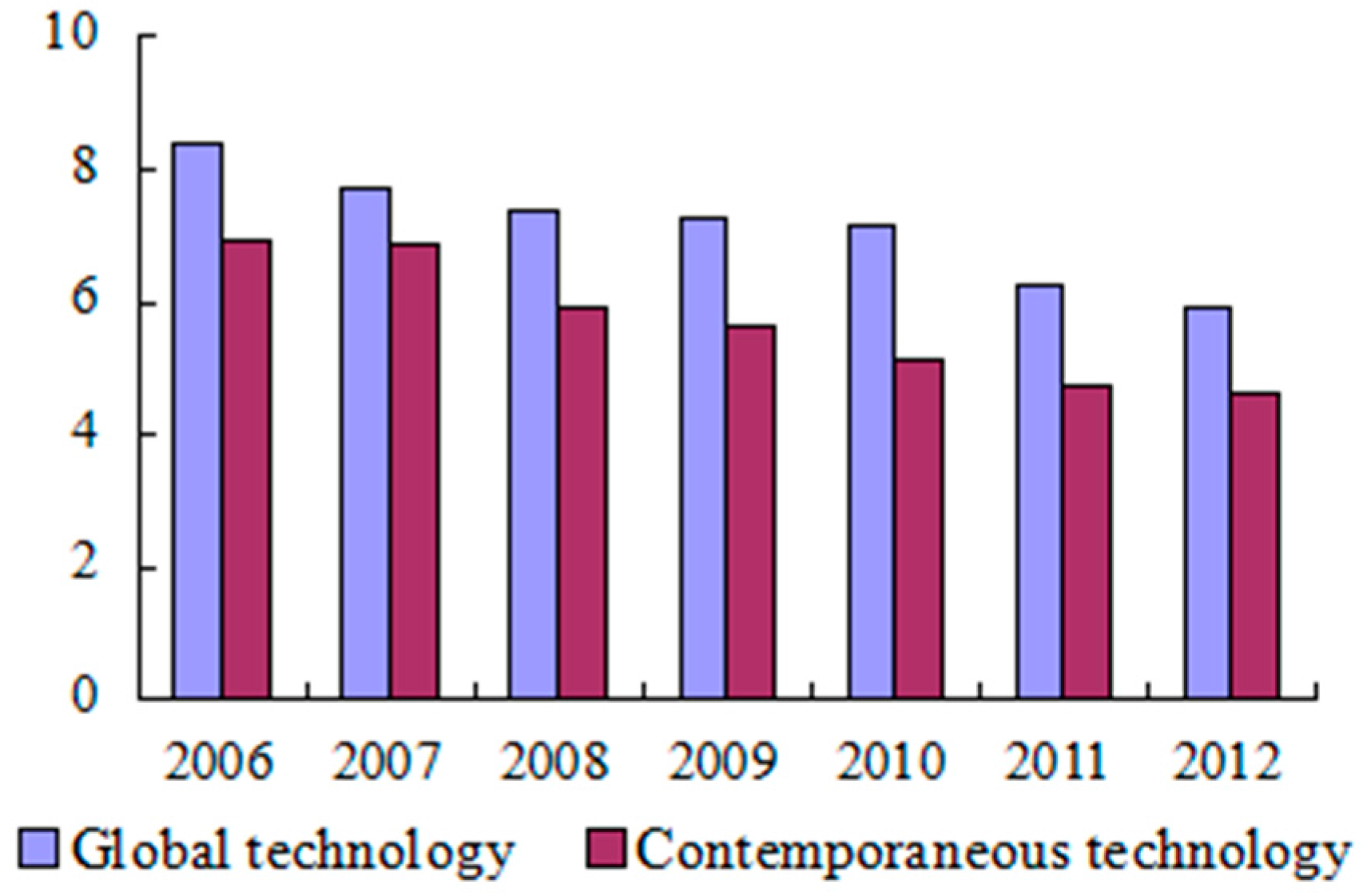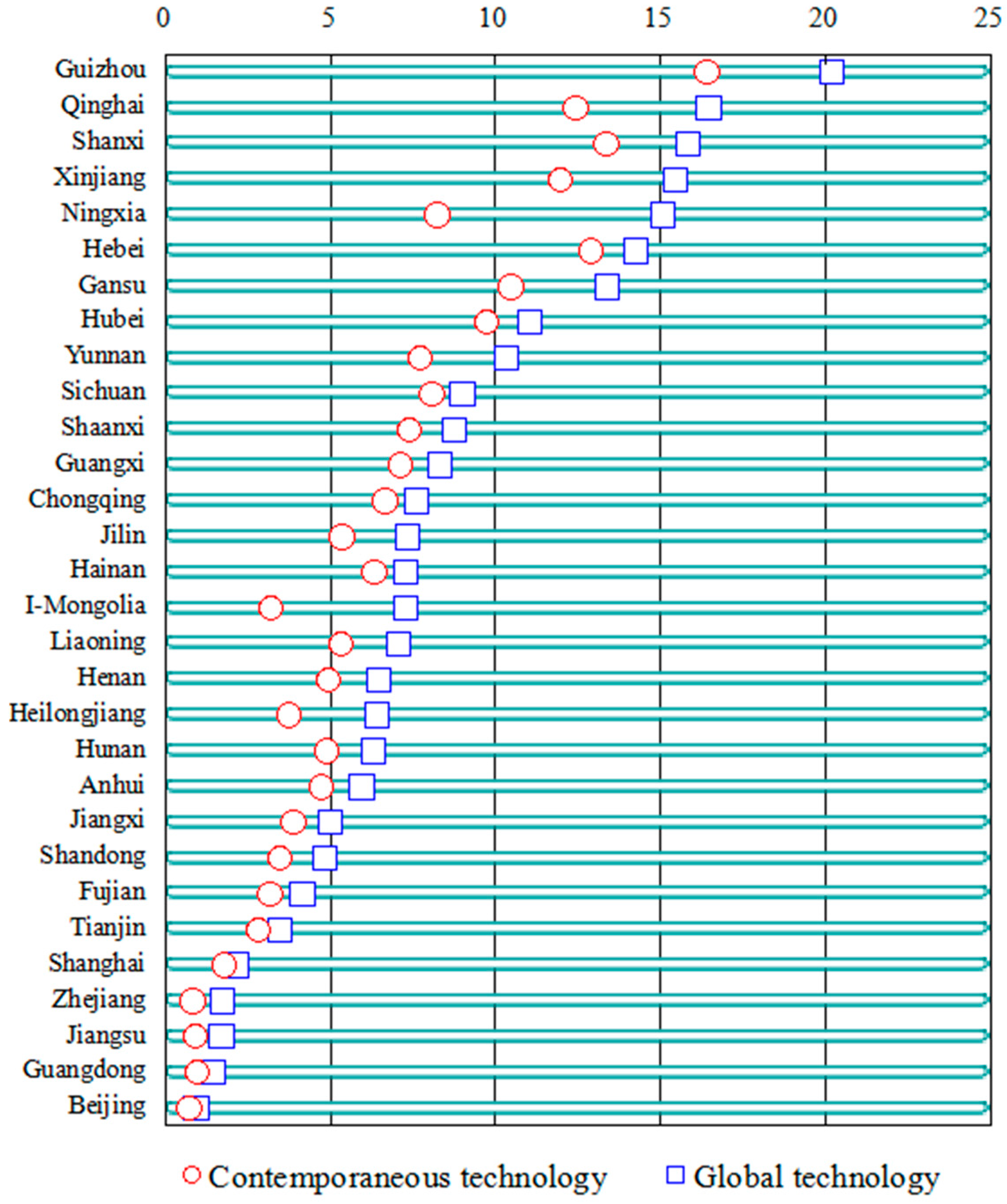Exploring Change in China’s Carbon Intensity: A Decomposition Approach
Abstract
:1. Introduction
2. Methodology
2.1. Shephard Energy Distance Function
2.2. Decomposition Model
3. Empirical Study
3.1. Data
3.2. Decomposition Results
3.3. The Potential CO2 Intensity Reduction
4. Conclusions
Acknowledgments
Author Contributions
Conflicts of Interest
References
- Vaninsky, A. Factorial decomposition of CO2 emissions: A generalized Divisia index approach. Energy Econ. 2014, 45, 389–400. [Google Scholar] [CrossRef]
- Liu, L.-C.; Wang, J.-N.; Wu, G.; Wei, Y.-M. China’s regional carbon emissions change over 1997–2007. Int. J. Energy Environ. 2010, 1, 161–176. [Google Scholar]
- Wu, L.; Kaneko, S.; Matsuoka, S. Driving forces behind the stagnancy of China’s energy-related CO2 emissions from 1996 to 1999: The relative importance of structural change, intensity change and scale change. Energy Policy 2005, 33, 319–335. [Google Scholar] [CrossRef]
- Wu, L.; Kaneko, S.; Matsuoka, S. Dynamics of energy-related CO2 emissions in China during 1980 to 2002: The relative importance of energy supply-side and demand-side effects. Energy Policy 2006, 34, 3549–3572. [Google Scholar] [CrossRef]
- Xu, B.; Lin, B. How industrialization and urbanization process impacts on CO2 emissions in China: Evidence from nonparametric additive regression models. Energy Econ. 2015, 48, 188–202. [Google Scholar] [CrossRef]
- Zhang, M.; Mu, H.; Ning, Y. Accounting for energy-related CO2 emission in China, 1991–2006. Energy Policy 2009, 37, 767–773. [Google Scholar] [CrossRef]
- Fan, Y.; Liu, L.-C.; Wu, G.; Tsai, H.-T.; Wei, Y.-M. Changes in carbon intensity in China: Empirical findings from 1980–2003. Ecol. Econ. 2007, 62, 683–691. [Google Scholar] [CrossRef]
- Chen, S. The abatement of carbon dioxide intensity in China: Factors decomposition and policy implications. World Econ. 2011, 34, 1148–1167. [Google Scholar] [CrossRef]
- Su, B.; Ang, B.W. Multiplicative decomposition of aggregate carbon intensity change using input-output analysis. Appl. Energy 2015, 154, 13–20. [Google Scholar] [CrossRef]
- Tan, Z.; Li, L.; Wang, J.; Wang, J. Examining the driving forces for improving China’s CO2 emission intensity using the decomposing method. Appl. Energy 2011, 88, 4496–4504. [Google Scholar] [CrossRef]
- Zhao, X.; Burnett, J.W.; Fletcher, J.J. Spatial analysis of China province-level CO2 emission intensity. Renew. Sustain. Energy Rev. 2014, 33, 1–10. [Google Scholar] [CrossRef]
- Wang, K.; Zhang, X.; Wei, Y.-M.; Yu, S. Regional allocation of CO2 emissions allowance over provinces in China by 2020. Energy Policy 2013, 54, 214–229. [Google Scholar] [CrossRef]
- Zhang, W.; Li, K.; Zhou, D.; Zhang, W.; Gao, H. Decomposition of intensity of energy-related CO2 emission in Chinese provinces using the LMDI method. Energy Policy 2016, 92, 369–381. [Google Scholar] [CrossRef]
- Xu, S.; Han, H.; Zhang, W.; Zhang, Q.; Long, R.; Chen, H.; He, Z. Analysis of regional contributions to the national carbon intensity in China in different five-year plan periods. J. Clean. Prod. 2017, 145, 209–220. [Google Scholar] [CrossRef]
- Xu, X.Y.; Ang, B.W. Index decomposition analysis applied to CO2 emission studies. Ecol. Econ. 2013, 93, 313–329. [Google Scholar] [CrossRef]
- Ang, B.W. Decomposition analysis for policymaking in energy: Which is the preferred method? Energy Policy 2004, 32, 1131–1139. [Google Scholar] [CrossRef]
- Ang, B.W.; Liu, N. Energy decomposition analysis: IEA model versus other methods. Energy Policy 2007, 35, 1426–1432. [Google Scholar] [CrossRef]
- Wang, C. Decomposing energy productivity change: A distance function approach. Energy 2007, 32, 1326–1333. [Google Scholar] [CrossRef]
- Li, M. Decomposing the change of CO2 emissions in China: A distance function approach. Ecol. Econ. 2010, 70, 77–85. [Google Scholar] [CrossRef]
- Wang, Q.; Chiu, Y.-H.; Chiu, C.-R. Driving factors behind carbon dioxide emissions in China: A modified production-theoretical decomposition analysis. Energy Econ. 2015, 51, 252–260. [Google Scholar] [CrossRef]
- Zhang, X.-P.; Tan, Y.-K.; Tan, Q.-L.; Yuan, J.-H. Decomposition of aggregate CO2 emissions within a joint production framework. Energy Econ. 2012, 34, 1088–1097. [Google Scholar] [CrossRef]
- Zhou, P.; Ang, B.W. Decomposition of aggregate CO2 emissions: A production-theoretical approach. Energy Econ. 2008, 30, 1054–1067. [Google Scholar] [CrossRef]
- Lin, B.; Du, K. Decomposing energy intensity change: A combination of index decomposition analysis and production-theoretical decomposition analysis. Appl. Energy 2014, 129, 158–165. [Google Scholar] [CrossRef]
- Kim, K.; Kim, Y. International comparison of industrial CO2 emission trends and the energy efficiency paradox utilizing production-based decomposition. Energy Econ. 2012, 34, 1724–1741. [Google Scholar] [CrossRef]
- Oh, D.-H. A global Malmquist-Luenberger productivity index. J. Prod. Anal. 2010, 34, 183–197. [Google Scholar] [CrossRef]
- Pastor, J.T.; Lovell, C.A.K. A global Malmquist productivity index. Econ. Lett. 2005, 88, 266–271. [Google Scholar] [CrossRef]
- Wang, H.; Zhou, P.; Zhou, D.Q. Scenario-based energy efficiency and productivity in China: A non-radial directional distance function analysis. Energy Econ. 2013, 40, 795–803. [Google Scholar] [CrossRef]
- Wu, F.; Fan, L.W.; Zhou, P.; Zhou, D.Q. Industrial energy efficiency with CO2 emissions in China: A nonparametric analysis. Energy Policy 2012, 49, 164–172. [Google Scholar] [CrossRef]
- China, Premium Database. Available online: http://www.ceicdata.com. (accessed on 7 Aprial 2015).
- National Bureau of Statistics of China. China Energy Statistical Yearbook 2007; China Statistics Press: Beijing, China, 2007. (In Chinese)
- National Bureau of Statistics of China. China Energy Statistical Yearbook 2008; China Statistics Press: Beijing, China, 2008. (In Chinese)
- National Bureau of Statistics of China. China Energy Statistical Yearbook 2009; China Statistics Press: Beijing, China, 2009. (In Chinese)
- National Bureau of Statistics of China. China Energy Statistical Yearbook 2010; China Statistics Press: Beijing, China, 2010. (In Chinese)
- National Bureau of Statistics of China. China Energy Statistical Yearbook 2011; China Statistics Press: Beijing, China, 2011. (In Chinese)
- National Bureau of Statistics of China. China Energy Statistical Yearbook 2012; China Statistics Press: Beijing, China, 2012. (In Chinese)
- National Bureau of Statistics of China. China Energy Statistical Yearbook 2013; China Statistics Press: Beijing, China, 2013. (In Chinese)
- Liu, Z.; Geng, Y.; Lindner, S.; Guan, D. Uncovering China’s greenhouse gas emission from regional and sectoral perspectives. Energy 2012, 45, 1059–1068. [Google Scholar] [CrossRef]
- National Bureau of Statistics of China. China Statistical Yearbook 2014; China Statistics Press: Beijing, China, 2014. (In Chinese)


| Symbol | Description |
|---|---|
| DEMF | the CO2 emission factor effect |
| DEMX | the effect of energy mix change |
| DPEI | the effect of potential energy intensity change |
| DSTR | industrial structure effect, accounting for the impact from output composition change |
| DBPC | the impact from technological change in energy use |
| DEC | the effect of energy efficiency change |
| DROS | the effect of regional output structure change |
| Year | Dtot | DEMF | DEMX | DSTR | DROS | DPEI | DEC | DBPC |
|---|---|---|---|---|---|---|---|---|
| 2006–2007 | 0.950 | 0.984 | 1.015 | 1.005 | 1.000 | 0.956 | 1.017 | 0.974 |
| 2007–2008 | 0.958 | 0.999 | 0.999 | 1.006 | 1.001 | 0.957 | 0.964 | 1.032 |
| 2008–2009 | 0.935 | 0.980 | 0.993 | 0.979 | 1.001 | 0.963 | 0.999 | 1.019 |
| 2009–2010 | 0.960 | 0.991 | 0.991 | 1.014 | 1.001 | 0.954 | 0.984 | 1.026 |
| 2010–2011 | 0.997 | 1.007 | 1.043 | 1.002 | 1.004 | 0.995 | 0.978 | 0.970 |
| 2011–2012 | 0.936 | 0.986 | 0.997 | 0.988 | 1.003 | 0.958 | 1.009 | 0.993 |
| Geometric mean | 0.956 | 0.991 | 1.006 | 0.999 | 1.002 | 0.964 | 0.992 | 1.002 |
| 2006–2012 | 0.762 | 0.946 | 1.038 | 0.995 | 1.010 | 0.802 | 0.952 | 1.013 |
| Province | Dtot | DEMF | DEMX | DSTR | DPEI | DEC | DBPC |
|---|---|---|---|---|---|---|---|
| Anhui | 0.712 | 0.965 | 0.990 | 1.146 | 0.663 | 0.965 | 1.017 |
| Beijing | 0.545 | 0.817 | 1.108 | 0.931 | 0.926 | 0.727 | 0.960 |
| Chongqing | 0.769 | 0.921 | 0.967 | 1.016 | 0.799 | 1.028 | 1.033 |
| Fujian | 0.748 | 0.978 | 1.039 | 1.002 | 0.798 | 0.903 | 1.021 |
| Gansu | 0.861 | 1.022 | 0.950 | 0.964 | 0.906 | 0.988 | 1.027 |
| Guangdong | 0.740 | 0.943 | 1.043 | 0.978 | 0.865 | 0.966 | 0.921 |
| Guangxi | 0.776 | 0.912 | 1.075 | 1.129 | 0.717 | 0.955 | 1.024 |
| Guizhou | 0.622 | 0.911 | 1.009 | 0.959 | 0.660 | 1.019 | 1.050 |
| Hainan | 1.155 | 1.103 | 0.965 | 0.888 | 1.237 | 0.986 | 1.002 |
| Hebei | 0.783 | 0.947 | 0.963 | 0.984 | 0.816 | 1.062 | 1.006 |
| Heilongjiang | 0.778 | 0.973 | 0.990 | 0.933 | 0.865 | 0.961 | 1.042 |
| Henan | 0.680 | 0.931 | 1.056 | 1.028 | 0.702 | 0.935 | 1.026 |
| Hubei | 0.744 | 0.901 | 0.888 | 1.053 | 0.743 | 1.155 | 1.029 |
| Hunan | 0.646 | 0.938 | 1.094 | 1.081 | 0.637 | 0.875 | 1.045 |
| I-Mongolia | 0.893 | 1.054 | 1.126 | 1.091 | 0.829 | 0.801 | 1.039 |
| Jiangsu | 0.796 | 0.966 | 1.077 | 0.912 | 0.903 | 0.913 | 1.016 |
| Jiangxi | 0.757 | 0.905 | 1.137 | 1.081 | 0.754 | 0.889 | 1.014 |
| Jilin | 0.657 | 0.976 | 1.080 | 1.092 | 0.641 | 0.887 | 1.003 |
| Liaoning | 0.780 | 0.980 | 1.235 | 1.034 | 0.787 | 0.785 | 1.008 |
| Ningxia | 0.901 | 0.993 | 1.060 | 0.956 | 0.950 | 0.906 | 1.041 |
| Qinghai | 0.944 | 0.910 | 0.983 | 1.101 | 0.862 | 1.073 | 1.036 |
| Shaanxi | 0.768 | 0.919 | 0.965 | 0.993 | 0.807 | 1.037 | 1.042 |
| Shandong | 0.758 | 0.949 | 1.048 | 0.926 | 0.848 | 0.940 | 1.033 |
| Shanghai | 0.685 | 0.960 | 0.998 | 0.861 | 0.895 | 1.051 | 0.882 |
| Shanxi | 0.777 | 0.985 | 1.132 | 0.981 | 0.803 | 0.858 | 1.031 |
| Sichuan | 0.688 | 0.785 | 0.880 | 1.099 | 0.678 | 1.323 | 1.012 |
| Tianjin | 0.633 | 0.990 | 0.859 | 0.962 | 0.756 | 1.035 | 0.990 |
| Xinjiang | 1.216 | 1.012 | 1.195 | 0.954 | 1.250 | 0.809 | 1.042 |
| Yunnan | 0.820 | 0.973 | 1.034 | 0.928 | 0.896 | 0.949 | 1.032 |
| Zhejiang | 0.724 | 0.913 | 0.995 | 0.952 | 0.818 | 0.994 | 1.030 |
© 2017 by the authors. Licensee MDPI, Basel, Switzerland. This article is an open access article distributed under the terms and conditions of the Creative Commons Attribution (CC BY) license ( http://creativecommons.org/licenses/by/4.0/).
Share and Cite
Du, K.; Lin, B.; Xie, C. Exploring Change in China’s Carbon Intensity: A Decomposition Approach. Sustainability 2017, 9, 296. https://doi.org/10.3390/su9020296
Du K, Lin B, Xie C. Exploring Change in China’s Carbon Intensity: A Decomposition Approach. Sustainability. 2017; 9(2):296. https://doi.org/10.3390/su9020296
Chicago/Turabian StyleDu, Kerui, Boqiang Lin, and Chunping Xie. 2017. "Exploring Change in China’s Carbon Intensity: A Decomposition Approach" Sustainability 9, no. 2: 296. https://doi.org/10.3390/su9020296
APA StyleDu, K., Lin, B., & Xie, C. (2017). Exploring Change in China’s Carbon Intensity: A Decomposition Approach. Sustainability, 9(2), 296. https://doi.org/10.3390/su9020296






